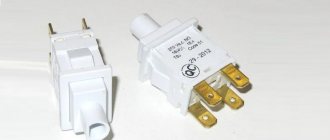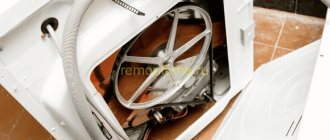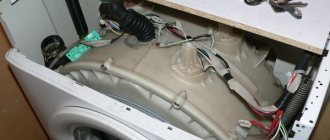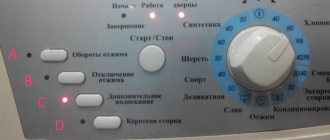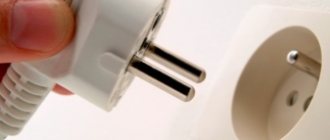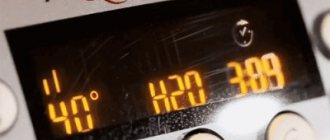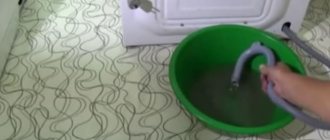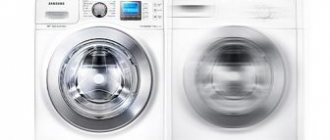Things are already in the drum, the powder is poured in, the program is selected and the water begins to boil. But as soon as it came to spinning and draining, the liquid remained in the drum. The problem of a washing machine not draining water is a very common one. You can repair it in several ways with your own hands, often without the help of a specialist. The main thing is to correctly diagnose the malfunction.
The connection manual is universal, it is suitable for all vertical and horizontal models of the brands Ariston, Bosch, Candy, Gorenje, Indesit, Samsung, Siemens, Zanussi, Ariston, Bosch, Aeg, Beko, Electrolux, Haier and others.
To start
The washing process has already begun
Usually, before starting the process, the “washing machine” stands for some time without moving, at most it will pour water into the tank. This is fine! The liquid is heated for better removal of stains and other contaminants.
But if the machine does not make any sounds for too long (from an hour to two) and does not start draining water, you will have to figure out what could have broken. For example, the control module could fail or the heating element (heating element) could burn out. Because of this, the water does not heat up to the required temperature to continue washing. Or vice versa - the liquid overheats and even boils.
Restart
The device may not drain water due to software glitches. In this case, you need to do the same as with a computer - force a reboot. Unplug the power cord for a couple of seconds and then plug it back in. In addition, try resetting the wash using the buttons on the control panel and setting the “Rinse and Spin” mode. Before forcibly turning off the machine from the network, we recommend that you read the instructions first.
Main causes of failure
There are plenty of reasons why the washing machine does not pump out water after stopping the program. Let's look at the TOP of the most common:
Clogged drain filter
It often happens that things are left in the pockets of clothes during washing. Surprisingly, even a receipt from a store or a coin can harm the drainage of water. Foreign objects along with the liquid pass through the drain filter. Gradually remaining on the surface, the clog accumulates to such an extent that it begins to interfere with the free drainage of water. It gets to the point where the lumen of the pipe is completely blocked by hair, debris, and pieces of clothing.
You can clean the filter without the help of a specialist:
- Cover the floor with rags, or better yet, find a suitable container to drain the water.
- At the very bottom of the washing machine, on the front side, find a plug under which the drain filter hole is hidden - place a basin or bucket.
- Open the filter cover. If you can’t do this with your fingers, pry the edge with a sharp object, such as a screwdriver.
- When the plug gives in, unscrew it along with the filter.
- If the problem is in the filter, then there will be a lot of different debris: hair, wool, coins, paper - all this needs to be removed.
- After thorough cleaning, reinsert the filter. Screw the cap tightly to prevent water from leaking in.
Drain hose fault
There are two possible problems with the drain hose: kinks or clogs.
The first option can be immediately ruled out if the hose is not clamped by anything and if there have been no recent changes in the bathroom or kitchen. But, just in case, check it out.
The second situation is more complicated. You will have to clear the hose of debris.
To do this, you need to figure out which side of your machine the pump is located on - or the drain pump, to which the base of the tube is attached.
- Remove the protective panel.
- Loosen the clamp so it can be easily removed.
- Disconnect the hose.
- A thin, long object will help clean the hose. You need to break through the blockage several times on each side.
- Hold the tube close to the water faucet and check if it flows.
- If the blockage is cleared and water flows through the tube freely, reconnect it.
Siphon clogged
If the drain hose is connected directly to the siphon, it is possible that it is clogged. This prevents water from leaving. Such a blockage can be eliminated by pushing the lump with a special cable or completely removing the siphon and cleaning it manually.
The pipes are clogged
The pipe that may become clogged comes from the pump (drain pump). Therefore, in case of blockage, you will have to manually disassemble the pump housing.
Instructions:
- Disassemble the pump body and unscrew the bolts that hold the drain assembly in place.
- Remove the pipe itself, removing the clamp and draining the water into a container prepared in advance.
- Inspect the pipe for blockages. If you see something that interferes with the water, remove it.
- Reassemble everything in reverse order.
Impeller blocked
This part is located directly behind the drain filter, on the motor shaft. Objects caught in the impeller block the entire operation algorithm, including draining water. If the washing machine makes noise when draining water, most likely there is a problem with this part.
First of all, try to turn it by hand, if nothing interferes with the movement and there are no foreign objects - the impeller is fine, perhaps the problem is in the motor. If you find a foreign object: a coin, a piece of paper, a pin, whatever, remove it. Most often, it is the hair that prevents normal water circulation: it gets wrapped up and thereby forms one big lump.
The pump burned out
When the machine makes noise, buzzes, spins the drum, but still does not drain the water, this is a clear sign of damage to the pump. The pump consists of several parts: motor, pipe, impeller and volute. Therefore, the clog that has accumulated in the first two parts also affects the pump. It idles the water without draining it, which leads to burnout of the motor winding. You cannot repair the pump yourself; you will have to replace it with a new one assembled. You can ask to rewind the motor winding, but most often this is not economically profitable.
The water level sensor is broken
The pressure switch controls the water level in the tank: either too much or not enough. When the sensor breaks, the control module no longer sees that there is still liquid in the tank. The device cannot be repaired - we recommend a complete replacement.
However, you don't need a wizard for this:
- Remove the top panel of the washer. It needs to be moved after unscrewing the bolts.
- Unscrew the pressure switch. It is often attached with only 3 screws.
- Disconnect the contacts and hose that go to the sensor. To unhook the tube, cut off the plastic ties - you will have to buy new ones in their place.
- Install a working device.
- Connect and tighten everything in reverse order.
More details about the water level switch here.
Damaged control board
The control board is called the “brain” of the entire washing machine. It receives outgoing signals from sensors and automatically gives commands to actuators, valves, motors, heating elements, and controls the hatch lock. Accordingly, in the event of a breakdown, these processes are disrupted. In the case of draining water, the signal from the control module does not go to the pump, and the water is not pumped out.
Most often, with such a breakdown, all the lights on the control panel of the washing machine will blink. They signal an error.
You can repair the board, but not yourself. You will need to either reflash the board or replace the programmer. It is better for the master to tell you about all the nuances.
Wires or contacts are damaged
The water drain may not be working due to wiring. For example, the contacts going to the pressure switch have oxidized, or the wires have simply worn out due to their long service life. It happens that the reason is that the pump does not have enough voltage to drain, due to rust on the motor contacts. Carefully inspect the wiring. If you understand electrics, replace it yourself; if not, don’t tempt fate and call a professional, otherwise repairing the washing machine will result in more serious problems.
Other reasons
The washing machine stops draining water not only due to internal breakdowns. The problem may occur due to a clog in the sewer pipe. It can be eliminated using special chemicals or, if the problem is serious, with a cleaning cable.
In addition, if you connect the machine directly to the sewer pipe, the problem may be in the height of the bend of the hose - the distance between the bottom point of the tube and the top. This is necessary so that the water does not leave the machine by gravity during washing. It is recommended to install the drain hose so that the bend is 60-90 cm from the floor. If this distance is greater, the pump may not be able to pump out water.
When connecting the hose directly to the sewer, do not forget about the drain seal - a special rubber band that will allow you to connect tubes of different diameters.
Operating rules
A washing machine is the same device as a microwave, oven and stove, which also require some care. Do you want to save on repairs and calling a technician? Do not ignore the rules for its operation.
These recommendations are indicated in the instructions, and most unit owners simply ignore them. But often the reason for a non-working drain is a blockage; you need to check the pockets.
This rule is in the instructions, although it is so simple, many housewives completely forget about its existence.
Other rules:
- You need to fully load the drum of the machine. You cannot wash only 1 towel. This causes the mechanism of the device to wear out faster.
- For bras, handbags, sneakers and other items with zippers and fasteners, you should buy a special laundry bag.
- Clothing must be fastened with a zipper or buttons. This way the machine is less likely to be damaged.
The operating rules were created by experienced specialists who took into account all the mistakes people make. It is important to follow them, because the performance of the device depends on it.
Features of breakdowns of different brands of washing machines
Below are the breakdown features of each of the popular brands of washing machines.
LG
The Korean company, at least in the washing machine industry, has proven itself to be a reliable laundry assistant. However, no one is perfect. If the device does not pump out water or does so very slowly, this is most often due to a clog in the drain filter, problems with the pump or impeller.
Bosch
Home appliances have always been at the forefront. But even they had problems with their work. First of all, as with everything else, check the drain filter and impeller for foreign objects. If everything is in order with them, the failure may not be mechanical, but software - the control board or water level sensor has failed.
Indesit
The weak point of these devices is poor electronics. Therefore, when the drain was not working, a breakdown was most often found in the control module. However, other reasons should not be dismissed ahead of time.
Samsung
Samsung appliances, and washing machines are no exception, are distinguished by their quality and stability of operation, so if problems with water drainage occur, they usually occur 5-7 years after purchase. The first step is to check whether the drain hose or pipe is clogged. Next we move on to the impeller. If after this the problem is not solved, you will have to check the electronics.
Ariston
Everyone is complaining about this manufacturer due to software glitches. If the board and pressure switch are in order, then check everything according to the list.
Failure of the control board
If the previous steps failed to identify the fault, this may indicate a breakdown of the washing machine control unit. This can happen for a number of reasons:
- Voltage drop, lightning strike.
- The control module tracks are poorly soldered.
- Water getting on board.
- Incorrect actions of the device owner, etc.
You should absolutely not try to repair the control unit yourself. This is a very complex process, during which you can permanently damage your LG washing equipment. To diagnose the board and fix the problem, it is recommended to contact a professional.
How to quickly drain water
To diagnose a breakdown yourself, you first need to drain the water from the drum.
Here are four ways to do this:
- Through the drain hose. This method comes to mind first. The main thing here is to make sure that the sleeve lies below the level of the tank. In this case, the water will flow by gravity. Next, place a bucket or any other container under the tube and wait until the liquid comes out.
- Through the drain filter. Here you will need low containers, because the filter is located almost to the floor. Place a container under the filter hatch and carefully unscrew the cap. There is no need to do this completely. It is enough to wait for the moment when the water flows.
- Emergency hose. Some equipment manufacturers (not all of them) introduce a special emergency hose into their devices, just for cases when you need to urgently drain the water in the tank. It is located under the plug, in the same place as the filter. Take out the tube, lower it into the prepared container and remove the plug.
- Drain pipe. You should resort to this method only when the previous methods did not work. Open the back panel of the machine and find the drain pipe. Most often it is under the drum. Throw rags on the floor and place a container under the pipe. Remove the clamp and carefully begin to disconnect the pipe itself. Be prepared for a lot of water to flow out of the tank.
Prevention recommendations
The lion's share of problems can be easily avoided by following simple recommendations for operating washing machines:
- Before washing, check your clothing pockets to ensure there is nothing in them. You even need to get store receipts. Do not allow the grinding and crackling of foreign objects to come from the drum.
- Do not fill the drum with clothes to capacity. It is better to wash clothes twice;
- It is better to wash bras in a special bag - a flying bone can damage the impeller;
- Do not pour too much powder into the tray, as it may become clogged. Lumps of powder settle on the walls of the pipe, and the drain hole narrows because of this. The problem may cause water to begin to accumulate in the air conditioner compartment.
- Buy a surge protector and connect the device through it. This will help prevent the consequences of voltage surges;
- Occasionally clean the machine parts to remove hair, foreign objects and debris. This can also help in cases where the machine is making a lot of noise.
Spin does not work
Having loaded things into the unit, housewives in most cases do not monitor the operation of the device, but rather go about their personal affairs. Once the process is complete, the user simply removes items from the drum and hangs them out to dry. It is at this moment that you can detect insufficient spin or its complete absence. How can you tell if the device has not squeezed out excess water?
According to two eloquent signs:
- Items removed from the drum will be very wet.
- There will be water left in the drum of the unit.
After making sure that the Indesit washing machine does not spin, you need to find out the cause of this malfunction.
